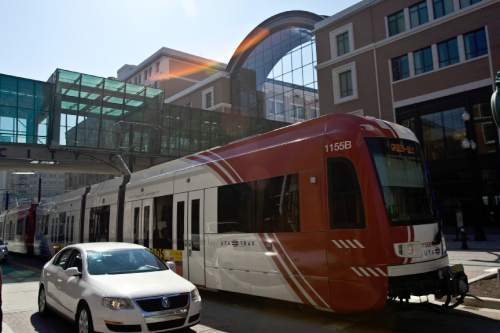This is an archived article that was published on sltrib.com in 2015, and information in the article may be outdated. It is provided only for personal research purposes and may not be reprinted.
The Utah Transit Authority is finding that the public has some deep concerns about possibly switching to fares based on the distance they travel, rather than the current practice of charging flat fees for trips of any length.
"It's too early to tell whether we will switch," or even offer some other system, said Andrea Packer, UTA communications director. The UTA board has placed a self-imposed Oct. 31 deadline to decide whether to impose distance-based fares next year.
Packer told the UTA board Wednesday that staff will try to tweak proposals — and do some experiments and more research this summer — based on what it has learned through a year of surveys, interviews, focus groups and experimenting with technology.
In research so far, UTA offered a few other fare variations besides distance-based fares for the public to consider.
They included:
• offering different flat fares for rail and bus, with some transfer credit — called "mode-based fare"
• charging lower flat fares than now, but charging every time a person boards a train or bus — including transfers
• offering flat fees on buses but distance-based fares on trains, called "station-based fare."
Amid such choices, she said focus groups have favored mode-based fare the most, followed by station-based fare. In third place was the proposed distance-based fare, followed by charging for every time a rider boards a bus or train.
Packer said UTA found the public repeated some key findings throughout the research process.
They want "simplicity, predictability. They want to know their fare ahead of time. They don't want to think about it too much. Transfers are highly valued to our regular riders," she said.
"We heard a lot about 'don't nickel and dime me'… every time they get on a vehicle."
Packer said UTA also found that riders — and non-riders — care more about improving the extent and frequency of service than they do about changing the fare structure.
A phone survey of 1,600 people was fairly evenly split between going to distance-based fares, or staying with a flat fee, she said. Those favoring distance-based fare generally felt it fair to charge riders for what they use.
She said the telephone survey also showed that 78 percent said a switch to distance-based fares would make no difference on their use of transit — but that means it could make a difference of up to 22 percent.
"We need to take what we heard and respond" by seeing if UTA can come up with a new fare system that will win support, Packer said. If UTA eventually seeks to make a change, it must hold public hearings first.
Whatever fares structure is eventually adopted "will be based on what we hear from people, whether it's small changes, whether it's significant changes," Packer said.
UTA is about to launch or extend some discount programs to further test some findings from the research, including responses showing that many want transit to be more affordable for families.
So beginning next Wednesday, UTA will offer will offer a group pass for $10, instead of the current $15. It allows up to four people to make a round trip on buses, TRAX and FrontRunner between 8:30 a.m. and midnight on the day of purchase.
Also beginning Wednesday, riders who use an electronic FAREPAY card will receive a 40 percent discount on buses — allowing a one-way trip for $1.50 instead of $2.50. It will help test the popularity of the "mode-based" fare idea.
UTA also has decided to extend through the end of the year a current 20 percent discount on TRAX for FAREPAY card users. It allows a one-way trip for $2 instead of the normal $2.50.



